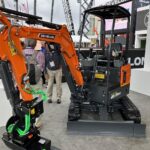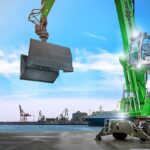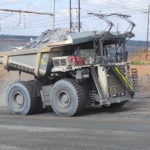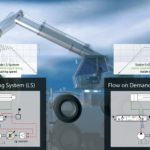Diesel-electric mobile machines provide many of the benefits of electrification without the shortcomings.
The push for electrification of mobiles equipment is in full swing, with dozens of OEMs showcasing battery-electric models that promise zero emissions, low noise, and minimal maintenance headaches.
But the current generation of electric machines also has serious drawbacks. They struggle to handle a full-day’s work without recharging, often requiring a “top-off” during lunch breaks. Current recharging infrastructure is lacking, especially in remote sites off the grid. Even the practicalities of charger plug compatibility have yet to be sorted out. And lithium-ion batteries don’t come close to matching the energy density of diesel fuel, and they’re expensive.
A more realistic solution, at least over the near term, may be hybrids. These machines rely on two power sources, typically an internal combustion engine (ICE) and an electric motor that work together — much like the powertrain on a Toyota Prius.
Such construction equipment combines the benefits of electric operation, say for working
indoors on pure battery power while the engine is shut off, along with the ease of refueling with diesel. Depending on the design, an ICE-driven generator recharges the batteries. Hybrids can substantially reduce fuel consumption and CO2 emissions, boost power output on-demand, and can use regenerative techniques to improve energy efficiency. And they often allow machine builders to opt for smaller engines, with less-expensive exhaust aftertreatment.
Some experts view hybrids as a “bridge” technology, a viable alternative to pure diesel-powered machines until electrification technology matures. Over the last few decades, mobile OEMs large and small have developed prototypes and commercial machines for construction, material handling, mining and forestry applications. Here are some recent developments.
Huddig backhoe loader
Huddig, Hudiksvall, Sweden, recently launched the 1370T hybrid backhoe loader at Conexpo 2023. It’s based on the company’s diesel-powered 1370 platform. The 1370T runs quieter than its conventional counterpart, generates 30% more power, and can operate solely on electricity, entirely on diesel, or by a combination of the two. The ICE can also run fossil-free on HVO 100 to reduce CO2 emissions.
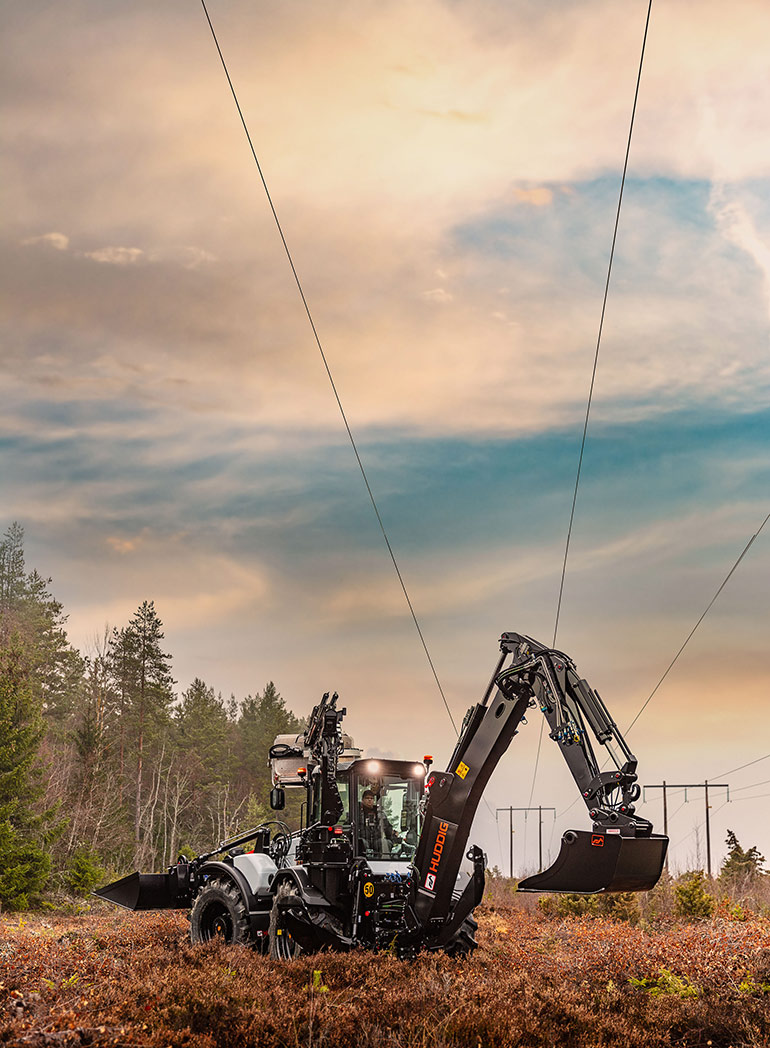
The model is powered by the company’s Tigon Technology system, which includes a 4-cylinder Cummins QSB 4.5-liter Stage V/Tier 4 turbocharged diesel engine. (In comparison, the conventional 1370 requires a 6-cylinder, 6.7 liter Cummins turbodiesel.) The electric drive includes a 44 kWh Alelion battery with four Schabmüller electric motor/generators (EMGs) for propulsion. Two Parker electric motors power the hydraulics.
In this 90-V system, the diesel engine via a transfer case drives the EMGs which charge the battery. The battery, in turn, powers four regenerative-type wheel motors equipped with two-speed hub reducers. The EMGs provide up to 30% additional power when needed and recharge the battery while working.
Four-wheel drive, with each wheel powered by a separate EMG, can adjust and calibrate individual wheel speed over 100 times per second. This provides optimal machine control with excellent traction regardless of ground conditions.
The hydraulics features a load-sensing system with 50 cc and 72 cc variable axial-piston pumps. Standard operating pressure is 233 bar (3,378 psi) with boost pressure to 260 bar (3,771 psi). Nominal maximum flow is 244 lpm at 2,000 rpm. The hydraulic system is compatible with environmentally friendly fluids.
The circuit includes internal servo-supply in the operational valves and power feedback for digging functions, and a heating system (circulation pumping) for cold starts. Steering is via a hydrostatic orbitrol control system with dual cylinders in the center pivot.
A third double-acting hydraulic outlet makes it possible to operate three hydraulic functions simultaneously. This upgrade, combined with the machine operating software, lets drivers adjust working parameters on the in-cab display and control, for example, grapple, rotation and tilt.
The 1370T can run for up to two hours (or 20 km of travel) on battery power alone and, when needed, the engine starts automatically and fully charges the battery in just 40 minutes. With a plug-in option, operators can work non-stop while stationary and charge the machine directly.
The machine’s EV mode makes it possible to operate silently and entirely without exhaust fumes, enabling work in residential areas at night and indoors. Finally, the 1370T has IoT compatibility which permits real-time monitoring of machine status to optimize service intervals and help prevent unnecessary downtime.
JLG work platforms
JLG Industries, a manufacturer of mobile elevating work platforms and telehandlers, has offered hybrid machines for more than two decades. The units operate on both battery and engine power and are designed for use indoors and out. According to the company, the hybrid machines limit fuel consumption and thus conserve energy. They generate zero emissions when running in electric-only mode and low emissions when a diesel generator charges the battery.
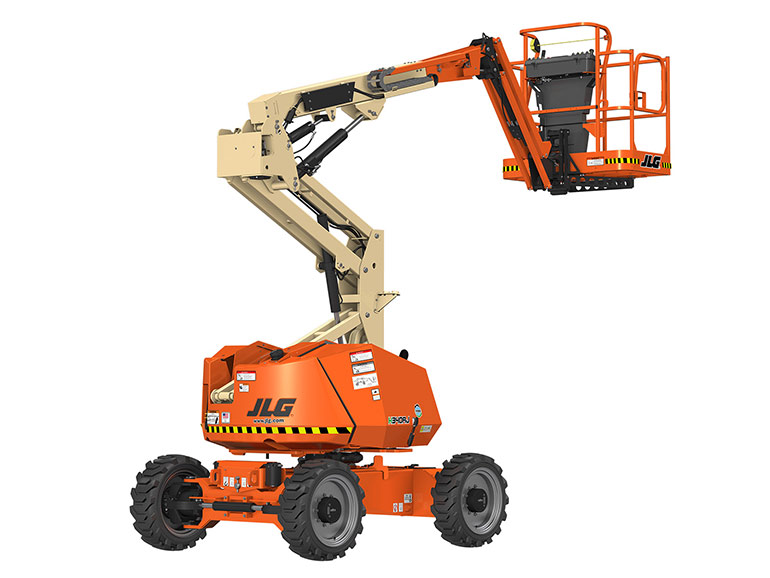
The company offers two versions. Machines such as JLG’s M Series and H340AJ Electric booms are series-type hybrids, primarily powered by batteries and electric motors. It is a hybrid by virtue of having an on-board engine-powered generator that charges the batteries. The equipment can also be plugged into an external electrical source to charge the batteries without running the engine. Indoors, the engine is shut off for emissions free, low noise operation; outdoors, the engine is run to increase operating time on the batteries.
Models such as the JLG Lift H800AJ are equipped with a parallel hybrid power system. A parallel hybrid is powered primarily by an engine but has an electric motor/generator that assists the engine when additional power is needed, charges the batteries, or serves as the primary power source when the engine is turned off. The H800AJ can use the engine and electric motor together outdoors when power is needed to climb steep grades or handle rough terrain. Indoors, the batteries power the electric motor for emissions free, low-noise operation.
JLG has also introduced a new Bi-Energy option. Available on its X770AJ and X1000AJ compact crawler boom lifts, this system includes two full-sized, independent power sources, combining an emissions-free lithium-ion battery pack with a diesel engine. For example, operators can use engine power to drive the machine to the work site, and then switch to all-electric battery power to work for an entire shift.
The X770AJ comes with a 100Ah, 76 V lithium-ion battery pack, while the X1000AJ has a 150Ah, 76 V lithium-ion battery pack; the batteries can be charged from an outlet at any time, including while the machine is in use. Both machines have a Kubota D902 21.6-hp (@ 3,200 rpm) diesel engine. This dual-power design means that Bi-Energy models can be used in a wide variety of settings from general construction, restoration and warehouse applications to environmentally sensitive job sites.
Manitou telehandler
The Manitou Group displayed a range of lift trucks, loaders and work platforms at Conexpo 2023, including a hybrid version of the MRT 2660e electric rotative telehandler, part of the company’s recently announced VISION+ range.
The standard, all-electric MRT 2660e has a loading capacity of 13,000 lb, a lifting height of 85 ft and a maximum outreach of 71 ft. It is powered by a 107 kW drive motor; and an 84 kW electric motor driving the hydraulics. The hydraulic pump is a fixed displacement piston type that offers 46 gpm flow. System pressure is rated at 5,076 psi. Electrohydraulic control and regenerative circuits ensure precision and efficiency.

A 700 V/65 kWh lithium-ion battery lets the unit operate for about four hours before recharging. An on-board 11 kW charger permits charging in 4 hours 30 minutes; an alternative 400 Vac on-board fast charger allows charging in less than an hour. A second 700 V/65 kWh battery can also be added to boost the range by an additional four hours.
Another option is the hybrid version of these models that serves as a range extender. For operation over substantially longer work shifts, the 2260e can be equipped with an optional E-Xtra 18.4 kW generator, powered by a Yanmar Stage V/Tier 4, 3-cylinder, 77 cu. in. engine rated at 25 hp. With a 17 gal fuel tank, the E-Xtra system recharges the batteries as needed and lets operators work for days without plugging in for a recharge.
Smart PTO
The Terex Hypower Smart PTO by Viatec is a simple and reliable plug-in electric power take-off (PTO). With straightforward hydraulic connections, the SmartPTO electrically powers all hydraulic functions of a utility truck — including outriggers, boom, jib and winch of an aerial device or boom functions of a digger derrick. The SmartPTO also provides battery power to the chassis allowing auxiliary applications such as lighting and in-cab HVAC while the truck engine is off.
The unit reliably powers all hydraulic functions for a full workday — same as with a diesel-powered PTO — but without engine noise and emissions. The system features LEDs and a digital display that shows battery charge level, ePTO usage, troubleshooting data, and other beneficial information.

According to Terex, the HyPower ePTO avoids a loud idling engine on the jobsite, limits worker exposure to exhaust fumes, and markedly reduces noise transmitted to the surrounding community. The cost of recharging the unit can be up to 95% lower than burning diesel to idle a truck on a jobsite. The unit also eliminates low-rpm idling which causes significant wear and tear on an engine, with one hour of idling equal to approximately 25 miles of driving. Thus, a SmartPTO can significantly reduce operating and maintenance expenses.
Viatec’s SmartPTO lets operators electrify a fleet quickly and at a much lower cost than purchasing new EVs, regardless of the chassis. Four lithium-NMC battery options offer capacities to 28.8 kWh. At the end of a shift, the bucket truck returns to home base and charges overnight using a standard wall outlet or a or Level II charger. The standard charger has 1,300 W, 100-260 Vac input with a five-hour recharge time for a 7.2 kWh battery. The optional 6,000 W fast charger reduces recharge time to one hour.
Hydraulic output pressure is up to 4,000 psi (275 bar) with output flow to 21 gpm (79 lpm). Because SmartPTO is a redundant system, crews can switch to the legacy diesel system for critical round-the-clock emergency situations, such as storm-related power outages. The SmartPTO can be factory installed or retrofit to existing vehicles. Terex offers it on a variety of Hi-Ranger aerials and digger derricks, which will be on display at The Utility Expo this September in Louisville, Ky.
Skylift digger derrick
Skylift provides easement specialty equipment for utility pole and transformer installations, traffic signal maintenance, tree trimming, and similar applications. The products are designed specifically for accessing tight alleyways and rear property utility applications.
Skylift’s MD 6000 E-Series hybrid is a battery/diesel-powered digger derrick that significantly reduces noise pollution and allows for safer and more effective communication between crew members. It emits little to no noise with no exhaust emission in the battery mode — ideal for residential applications.

It can operate under full electric or diesel power without affecting digging torque. The machine features a 25 hp Kubota Tier 4 diesel engine with a 10 gal fuel tank; and a 51 V, 300 Ah capacity battery (≈ 15 kWh) powering a 20 kW electric motor. A fixed-displacement hydraulic piston pump supplies 16 gpm with a system operating pressure of 3,000 psi. Two hydraulic tool circuits supply auxiliary power. The winch is rated to 6,000 lb and the auger drive to 5,800 ft-lb.
The MD 6000 allows line crews to work at greater capacities and heights when installing heavier poles. According to the company, the digger derrick is the only proportional hydraulic-controlled machine available on the market. Skylift equipment will be on display at The Utility Expo.
Logset harvesters
Finnish forest-machinery manufacturer Logset has developed several hybrid harvesters that have a diesel engine, electric motor/generator and supercapacitors for energy storage. It aims to solve the problem with typical harvesters: the diesel engine transitions from idle to full-throttle numerous times every minute over an entire workday. That equates to poor fuel economy and excessive particulate and CO2 emissions.

In comparison, the hybrid’s diesel engine runs at a constant 1,200 to 1,500 rpm with substantially fewer peaks. That means the engine runs at its most efficient regardless of demand. When the harvester faces a higher load requirement, the electric motor (supplied by the capacitors) reacts instantaneously and delivers additional power and torque in fractions of a second. The reduction in particulate emissions is substantial, according to Logset. And the electric motor becomes a generator and charges the capacitors when extra power is not needed.
The effects of the hybrid system on machine performance are eye-opening. For example, on the 12H GTE harvester, an AGCO Power 7.4-liter Stage V engine produces 291 hp (214 kW at 1,850 rpm), but the combined engine + electric motor raises maximum power to 510 hp (380 kW at 2,000 rpm) and maximum torque at 1,500 rpm of 1,475 ft-lb (2,000 Nm).
The Logset 12H GTE Hybrid also includes double-circuit hydraulics with two work pumps each supplying 210 lpm (55 gpm) at 1,000 rpm. The double-circuit guarantees sufficient hydraulic oil flow for processing heavy and difficult timber, along with a powerful crane and robust hydrostatic transmission.
The system also reduces operating costs. Without the hybrid, a similar machine would require a much larger engine consuming significantly more fuel to generate the same power and torque. And because the hybrid system eliminates power peaks, stable engine performance saves significant amounts of fuel, prolongs the lifespan of the engine, and lowers maintenance costs.
Hybrid technology suits harvesters well, according to Logset. Peak loads never strain the diesel engine and the operator has sufficient power to handle several tasks simultaneously: move the machine, operate the crane, and efficiently process a tree.
The machines are said to be highly productive models designed for profitable large-scale harvesting. The benefits of hybrid technology are particularly notable in established forests with large trees. The hybrid harvester is not meant for small thinnings.
Sidebar — sustainable forestry
Ponsse, based in Vieremä, Finland, is a leading manufacturer of cut-to-length forest machines like harvesters and forwarders. The company embraces sustainable forestry and carbon-neutral operations, and has partnered with Epec to introduce the EV1, a hybrid forwarder with a 15-ton load capacity.

The concept machine’s traction transmission and hydraulic actuators run solely on energy from batteries, which are charged using a Range Extender combustion engine. At the heart of the system is the Epec Flow Power Distribution Unit, which connects electric motors, batteries and actuators. Ponnse’s EV1 features powerful hydraulics, and precise crane and grapple control makes loading safe and reliable. Maximum reach of the loader is 10 meters.


